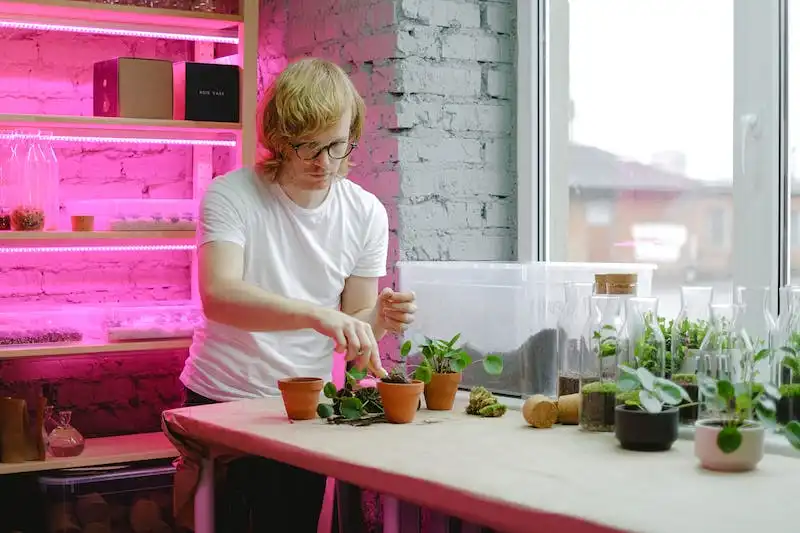Ferns are a popular addition to any landscape, adding a touch of grace and beauty to both larger garden areas and smaller container plantings. They are known for their long-lived foliage, which can reach impressive lengths and create high-quality selections for outdoor plantings. Taking care of outdoor ferns is relatively easy, with a few key steps to ensure their health and beauty throughout the year. This article will provide you with everything you need to know about caring for ferns in the garden.
When it comes to taking care of outdoor ferns, the first thing to note is their preferred growing conditions. Most ferns enjoy a shady location that is sheltered from direct sunlight. They are also fond of moist soil that is well-drained, so it is important to ensure proper watering and drainage to keep them healthy. Additionally, ferns prefer a slightly acidic soil with a pH between 5.5 and 7.0, so testing and amending the soil if needed is recommended.
Another important aspect of caring for outdoor ferns is grooming. Ferns have delicate foliage that can easily get damaged, so it is necessary to avoid any rough handling or brushing against their fronds. When grooming, make sure to use gloves to protect your hands and handle the fronds with care. Remove any dead or damaged fronds by cutting them off at the base of the plant, using clean and sterilized pruning shears. This will help promote new growth and maintain the overall health and appearance of the fern.
In terms of pest control, ferns are generally free from major pest problems. However, they are susceptible to scale, a plant-eating insect that can infest their fronds and cause damage. If you notice signs of scale on your ferns, such as small bumps or sticky residue on the foliage, you can remove them by gently washing the fronds with a mild soap and water solution. Alternatively, you can use an insecticide specifically formulated for scale insects, following the instructions on the package carefully.
When winter comes, ferns need some special care to ensure their survival. Some ferns, like the Boston fern (Nephrolepis exaltata ‘Bostoniensis’) and the Autumn fern (Dryopteris erythrosora), are not cold-hardy and need to be brought indoors before the first frost. Make sure to choose a bright and cool location for overwintering, and reduce watering to keep the soil slightly moist. Other ferns, such as the Christmas fern (Polystichum acrostichoides) and the Southern lady fern (Athyrium asplenoides), are more cold-tolerant and can be left outdoors. However, it is recommended to provide some protection by mulching around the base of the plants with a 2 to 3-inch layer of organic material, such as straw or wood chips. This will help insulate the roots and protect the ferns from extreme cold temperatures.
Finally, when it comes to selecting ferns for your garden, there are numerous options to choose from. Some popular choices include the Japanese painted fern (Athyrium niponicum ‘Pictum’), the Southern shield fern (Thelypteris kunthii), and the Christmas fern (Polystichum acrostichoides). These ferns are all easy to grow and provide a decorative touch to any garden or landscape. Remember to consider the specific growing conditions of your area and choose ferns that are well-suited to your climate and soil type.
In conclusion, taking care of outdoor ferns is a rewarding and enjoyable aspect of gardening. By providing the right conditions, regular grooming, and winter protection when needed, you can ensure the health and longevity of your ferns. So, go ahead and add these graceful plants to your garden, and enjoy their beauty for years to come!
Growing Ferns
Growing ferns can add a beautiful touch to any garden. There are many different types of ferns to choose from, such as Florida ferns, Boston ferns, and many more.
One of the latest trends in fern gardening is the Cyrtomium fern, also known as the Japanese holly fern. This fern is native to Japan and thrives in shady habitats. It is a great choice for gardeners who want to add a touch of elegance to their outdoor space.
Ferns tend to be hardy plants that can withstand harsh winters. They come in a variety of sizes, from low-growing ferns that stay under a foot tall to giant varieties that can reach several feet in height. Choosing the right fern for your garden depends on your specific requirements.
One commonly asked question is whether ferns can be planted in full sun. While some ferns, such as the Boston fern, do best in partial shade, others, like the Osmunda cinnamomea fern, can tolerate direct sunlight. It is important to research the specific requirements of the fern species you are working with.
Ferns thrive in woodland and shady areas, so providing them with the right conditions is key. They prefer well-draining soil that is rich in organic matter. Adding compost or peat moss to the soil can help improve its drainage and moisture-retaining capabilities.
When planting ferns, it is important to separate them enough to allow air circulation. This will help prevent fungal diseases, such as fern mold. Mulching around the ferns can also help retain moisture and suppress weed growth, creating a healthier environment for the plants.
Ferns can be propagated through division, or by collecting spores and growing them into new plants. When dividing a fern, make sure to carefully remove the plant from its pot or the ground, separating the roots into smaller sections. Planting each section individually will help the ferns establish themselves more quickly.
Many ferns, such as the Davillia fejeensis fern, have hairy or fuzzy leaves that add an interesting texture to the garden. These ferns are often used as a focal point in gardens and can be a beautiful addition to any landscape.
In conclusion, growing ferns can be a rewarding experience for gardeners. With their wide range of species and unique characteristics, ferns can add a touch of elegance and beauty to any outdoor space. By providing the right conditions and care, gardeners can enjoy the beauty of ferns year-round.
Temperature
Ferns are a popular choice for outdoor gardens due to their ability to thrive in a range of temperatures. However, different fern varieties have specific temperature preferences and requirements. It is important to consider these temperature needs when caring for your outdoor ferns.
Most ferns prefer temperatures between 60 and 75 degrees Fahrenheit (15 to 24 degrees Celsius). Some fern varieties, like the Matteuccia species, can withstand lower temperatures and even frost. Others, like the Plumosus fern, prefer warmer temperatures.
When potting your ferns, it is important to choose a location that provides the ideal temperature conditions. Ferns should be planted in well-drained soils that can retain moisture but also allow excess water to drain. To improve drainage, you can add a few tablespoons of sand or pebbles to the potting mix.
During the colder months, it is important to protect your ferns from freezing temperatures. If you live in an area where temperatures regularly drop below freezing, you may need to bring your ferns indoors or provide them with some form of frost protection. Simply covering the ferns with a cloth or placing them in a sheltered location can help to prevent frost damage.
Remember to take into consideration the temperature variations throughout the year when planning the location for your ferns. Some ferns prefer cooler temperatures in the spring and fall, while others thrive in warmer summer conditions. Be sure to research the specific temperature requirements for the fern varieties you have chosen.
Grooming and care for ferns can also be affected by temperature. Warmer temperatures may cause ferns to grow faster and require more frequent grooming. Removing dead fronds and separating crowded crowns can help to keep your ferns healthy. If you notice any pest problems, such as scale insects, it is important to address them promptly as they can affect the overall health of the fern.
References:
- Egendorf, S. P. (1991). Ferns: Excluding filmy ferns and water ferns. Gale
- Sankaram, S. V. (1996). Ecological requirements for diversity and community structure among ontario ferns
- Platycerium cuneatum (Boston fern). (n.d.). Retrieved from https://www.gardeningknowhow.com
- Platycerium exaltatum: Staghorn fern. ( 2025, March). Retrieved from https://www.anbg.gov.au
- Platycerium ridleyi. (n.d.). Retrieved from https://www.apsnet.org
- Platycerium expansa. (n.d.). Retrieved from https://www.anbg.gov.au
- Platycerium alcornii. (n.d.). Retrieved from https://www.nzpcn.org.nz
- Platycerium formosum: Kimberly queen fern. ( 2025, March). Retrieved from https://www.gardeningknowhow.com
- Platycerium wandae. (2010, October). Retrieved from https://www.tropicos.org
- Ferns. (n.d.). Retrieved from https://aggie-horticulture.tamu.edu
- Goldenrods: potential and limits for their use in desert restoration. I. establishment and effects of their host on other special pests. (1993). Southwest Environmental Health, 4(4), 21–24
Humidity
Humidity levels play a crucial role in the care of outdoor ferns. Most ferns are naturally found in woodland environments where the air is moist and humidity levels are high. To successfully grow ferns in your garden, it is important to provide them with the right level of humidity.
Ferns are known for their ability to tolerate high humidity levels, and some varieties, like the Huguenot fern, thrive in year-round humid conditions. High humidity helps ferns to retain moisture and prevents them from drying out. It also creates a lush environment that mimics their natural habitat.
However, excessive humidity can often lead to problems such as mold growth. To maintain a healthy humidity level, it is best to follow a few tips:
1. Provide a faster-draining soil mix, as ferns prefer moist but not waterlogged conditions.
2. Avoid planting ferns directly near pine trees or other plants that release volatile oils, as these can inhibit fern growth.
3. Water ferns in the early morning to allow the fronds to dry out during the day, reducing the risk of diseases.
4. Use specialized humidity trays or create a humid microclimate around your ferns by placing them in a container and surrounding it with moist pebbles or a tray of water.
5. Prune off any dead or dying fronds to improve air circulation and reduce the risk of mold and mildew.
6. If your ferns are potted, make sure to water them thoroughly until it drains out of the bottom of the pot. This ensures that the roots receive enough moisture.
7. To increase humidity levels in the surrounding area, you can place a bowl of water near the ferns or use a room humidifier.
Remember that ferns are long-lived plants and show excellent growth in high-humidity environments. The humidity levels should be kept constant throughout the year to support their growth. Additionally, ferns are particularly sensitive to dry air and can suffer from brown or crispy fronds if the humidity drops too low.
By carefully planning and maintaining the right humidity conditions, you can ensure the success of your outdoor fern garden. Always observe the needs of your specific fern species, as some may require special humidity conditions. For example, the dwarf asplenium prefers higher humidity, while the cheilanthes is more tolerant of drier conditions.
Observe the soil moisture and adjust your watering schedule accordingly, as outdoor ferns in containers may require more frequent watering. Be sure to fertilize your ferns with a balanced fertilizer during the growing months to provide them with the necessary nutrients. Ferns also benefit from a limestone concentration in the soil, which allows them to absorb nutrients more effectively.
Finally, note that ferns reproduce through spores, and these spores are produced on the undersides of the fronds. Removing the spore-producing fronds can help redirect the plant’s energy towards leaf growth. However, if you are looking to produce new ferns, leave some fronds in place to allow spore propagation.
Overall, maintaining the right humidity levels is crucial for the healthy growth of outdoor ferns. By creating a humid environment and removing any surrounding hazards, you can enjoy the beauty of these lush green plants in your garden or other outdoor plantings.




